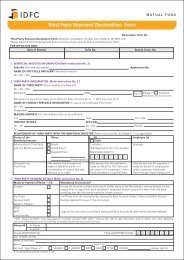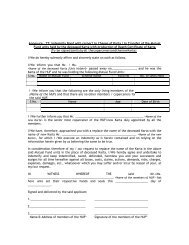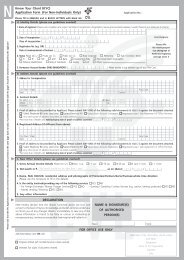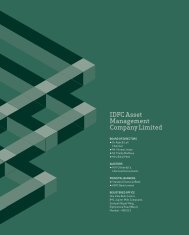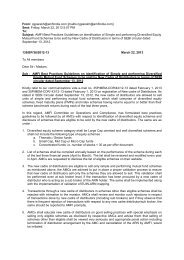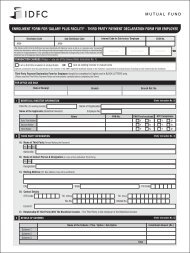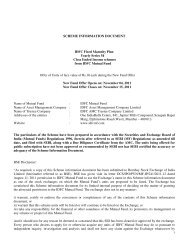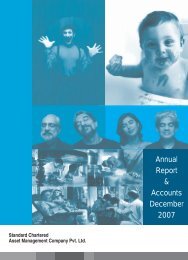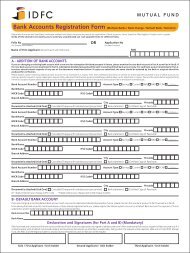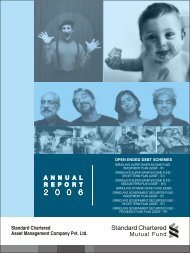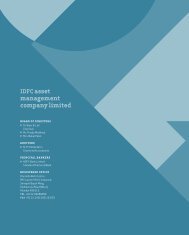IDFC ASSET MANAGEMENT COMPANY LIMITED - IDFC Mutual Fund
IDFC ASSET MANAGEMENT COMPANY LIMITED - IDFC Mutual Fund
IDFC ASSET MANAGEMENT COMPANY LIMITED - IDFC Mutual Fund
You also want an ePaper? Increase the reach of your titles
YUMPU automatically turns print PDFs into web optimized ePapers that Google loves.
Notes to financial statements FOR THE YEAR ENDED MARCH 31, 2013<br />
01 Nature of operations<br />
<strong>IDFC</strong> Asset Management Company Limited ('the Company') is a public limited company, incorporated in India and regulated by The Securities<br />
Exchange Board of India (SEBI). The Company provides asset management services to <strong>IDFC</strong> <strong>Mutual</strong> <strong>Fund</strong>.<br />
02 Basis of preparation<br />
The financial statements of the Company have been prepared in accordance with generally accepted accounting principles in India. The Company<br />
has prepared these financial statements to comply in all material respects with the accounting standards notified by the Companies (Accounting<br />
Standards) Rules, 2006, (as amended), the relevant provisions of the Companies Act, 1956 and the applicable guidelines issued by SEBI. The<br />
financial statements have been prepared on the accrual basis under the historical cost convention. The accounting policies followed in the<br />
preparation of financial statements are consistent with those followed in the previous year.<br />
03 Significant accounting policies<br />
a Use of estimates<br />
The preparation of financial statements in conformity with Indian GAAP requires the Management to make judgments, estimates and assumptions<br />
that affect the reported amounts of revenues, expenses, assets and liabilities and the disclosure of contingent liabilities at the end of reporting<br />
period. Although these estimates are based on management's best knowledge of current events and actions, uncertainty about these assumptions<br />
and estimates could result in the outcomes requiring a material adjustment to the carrying amounts of assets or liabilities in future periods.<br />
b Investments<br />
Investments which are readily realisable and intended to be held for not more than one year from the date on which such investments are made are<br />
classified as current investments. All other investments are classified as long-term investments. On initial recognition, all investments are measured<br />
at cost. The cost comprises purchase price and directly attributable acquisition charges such as brokerage, fees and duties.<br />
Long-term investments are carried at acquisition cost. However, a provision is made for diminution other than temporary on an individual basis.<br />
Current investments are carried at lower of cost or fair value on an individual investment basis.<br />
On disposal of an investment, the difference between its carrying amount and the net disposal proceeds is charged or credited to statement of profit<br />
and loss.<br />
c Tangible fixed assets<br />
Fixed assets are stated at cost of acquisition, including any cost attributable for bringing the asset to its working condition for the intended use, less<br />
accumulated depreciation and accumulated losses, if any. Gains or losses arising from derecognition of fixed assets are measured as difference<br />
between the net disposal proceeds and the cost of the assets less accumulated depreciation upto the date of disposal and are recognised in the<br />
statement of profit and loss when asset is derecognised. Leasehold Improvements are shown at historical cost less accumulated depreciation.<br />
Subsequent expenditure related to an item of fixed asset is added to its book value only if it increases the future benefits from the existing asset<br />
beyond its previously assessed standard of performance. All other expenses on existing fixed assets, including day-to-day repair and maintenance<br />
expenditure and cost of replacing parts, are charged to the statement of profit and loss for the period during which such expenses are incurred.<br />
d Depreciation on fixed assets<br />
Depreciation is charged at the rates prescribed in Schedule XIV of the Companies Act, 1956 as per written down value method. Certain electronic<br />
items are depreciated over a period of two years on straight line method based on the management’s estimate of the useful life of assets.<br />
Depreciation in respect of leasehold improvements is provided on the straight line method over the extended lease term or five years whichever is<br />
earlier.<br />
Depreciation on additions during the period is provided on a pro-rata basis. Assets costing `5,000 or less are fully depreciated in the year of<br />
purchase.<br />
e Intangible assets and amortisation<br />
Intangible assets acquired separately are measured on initial recognition at cost. Following initial recognition, intangible assets are carried at<br />
cost less accumulated amortisation and accumulated impairment losses, if any. Intangible assets are amortised on a straight line basis over the<br />
estimated useful life. The amortisation period and the amortisation method are reviewed at least at each financial year end. If the expected useful<br />
life of the asset is significantly different from previous estimates, the amortisation period is changed accordingly. Gains or losses arising from<br />
derecognition of an intangible asset are measured as the difference between the net disposal proceeds and the carrying amount of the asset and<br />
are recognised in the statement of profit and loss when the asset is derecognised.<br />
f Impairment of intangible assets<br />
The Company assesses at each reporting date whether there is an indication that an asset may be impaired. If any indication exists or when annual<br />
impairment testing of an asset is required, the Company estimates the asset's recoverable amount. An asset's recoverable amount is the higher of<br />
an assets or cash generating units (CGU) net selling price and it's value in use. The recoverable amount is determined for an individual asset unless<br />
the asset does not generate cash inflows that are largely independent of those from other assets or groups of assets. Where the carrying amount<br />
<strong>IDFC</strong> <strong>ASSET</strong> <strong>MANAGEMENT</strong> <strong>COMPANY</strong> <strong>LIMITED</strong> | 279



